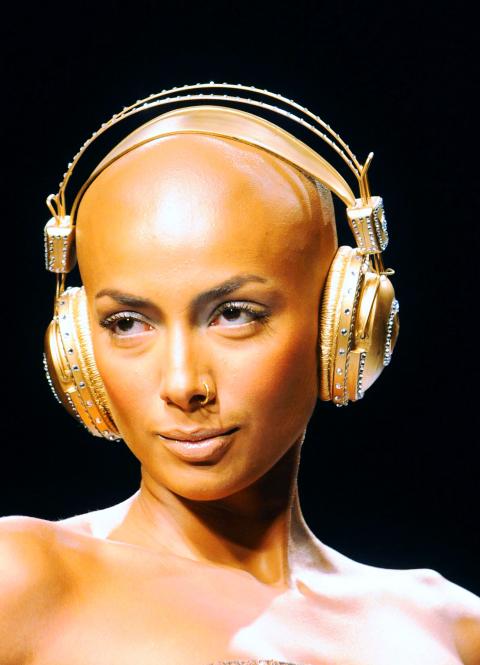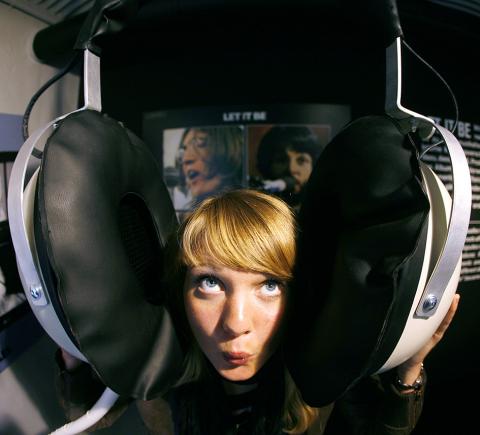It seems like only yesterday that hooking Apple’s white flex into your ears was just about the coolest thing that anyone could do on public transport. Today those little earbuds give out a different message, however. Sure you’ve got an iPod, they say, but you don’t know anything about fashion or music. Because — as you may have noticed if you’ve seen any pro soccer player getting on to a team bus recently — those who can afford it buy designer headphones these days.
“Now that digital music is so firmly established and growing,” HMV’s head of technology Ewan Pinder explains, “many consumers are becoming increasingly aware that to fully appreciate and enjoy the music via this new channel you also need to be able to listen to it in the sound quality intended by the studios.”
So seriously does HMV take the trend, in fact, that the UK’s tottering high-street music chain now puts designer headphones at the heart of its revival plans. Currently, the company lists 146 different kinds on its Web site, and last week chief executive Simon Fox announced that 25 percent of floor space would soon be given over to electronic devices, citing the headphone market alone as being worth around US$242 million. In the US, the trend is strongly upward too, with sales increasing 30 percent in value between 2009 and last year. The average amount spent on a headphone sale in the UK is US$24, but this figure too is rising.

Photo: AFP
As these things go, the headphones craze is actually quite rational. If you can afford to carry round a US$900 smartphone filled with US$500 worth of music, then it does seem like a false economy to listen to it with the cheap, hissy earphones that fell out of the box. Better headphones also tend to leak less, which your fellow passengers will be grateful for. And there is some evidence that, by blocking out external noise more effectively, they also dissuade users from turning the volume up too high, which may protect their hearing in the long term.
Even so, this has mostly been a fashion thing, especially since celebrities got involved. The big beast here is Dr Dre, who released his Beats range in 2008, in partnership with the electronics firm Monster. Retailing for anything up to about US$700, these headphones have been worn by international stars such as Thierry Henry and Wayne Rooney. New lines endorsed by Lady Gaga, P Diddy and Justin Bieber have subsequently been added to the Beats range. And now Ludacris, 50 Cent and Snoop Dogg, with different companies, have also got in on the act.
“Certainly in the last 12 months, people have been looking for a fashion product that sounds good,” says Linda Irvin, product manager at Sennheiser, which has recently launched its own range with Adidas. “There’s also been a trend towards larger-sized headphones, which means you have more opportunity to introduce color, lifestyle and fashion into a product.” In part, this has meant designing headphones specially to look good when they are not being used. “It’s an urban street trend to wear them not plugged in, but loose around the neck,” Irvin explains. Just don’t do it, I’d advise, with anything from Justin Bieber’s purple Just Beats range.

Photo: AFP

Behind a car repair business on a nondescript Thai street are the cherished pets of a rising TikTok animal influencer: two lions and a 200-kilogram lion-tiger hybrid called “Big George.” Lion ownership is legal in Thailand, and Tharnuwarht Plengkemratch is an enthusiastic advocate, posting updates on his feline companions to nearly three million followers. “They’re playful and affectionate, just like dogs or cats,” he said from inside their cage complex at his home in the northern city of Chiang Mai. Thailand’s captive lion population has exploded in recent years, with nearly 500 registered in zoos, breeding farms, petting cafes and homes. Experts warn the

The unexpected collapse of the recall campaigns is being viewed through many lenses, most of them skewed and self-absorbed. The international media unsurprisingly focuses on what they perceive as the message that Taiwanese voters were sending in the failure of the mass recall, especially to China, the US and to friendly Western nations. This made some sense prior to early last month. One of the main arguments used by recall campaigners for recalling Chinese Nationalist Party (KMT) lawmakers was that they were too pro-China, and by extension not to be trusted with defending the nation. Also by extension, that argument could be

Aug. 4 to Aug. 10 When Coca-Cola finally pushed its way into Taiwan’s market in 1968, it allegedly vowed to wipe out its major domestic rival Hey Song within five years. But Hey Song, which began as a manual operation in a family cow shed in 1925, had proven its resilience, surviving numerous setbacks — including the loss of autonomy and nearly all its assets due to the Japanese colonial government’s wartime economic policy. By the 1960s, Hey Song had risen to the top of Taiwan’s beverage industry. This success was driven not only by president Chang Wen-chi’s

Last week, on the heels of the recall election that turned out so badly for Taiwan, came the news that US President Donald Trump had blocked the transit of President William Lai (賴清德) through the US on his way to Latin America. A few days later the international media reported that in June a scheduled visit by Minister of National Defense Wellington Koo (顧立雄) for high level meetings was canceled by the US after China’s President Xi Jinping (習近平) asked Trump to curb US engagement with Taiwan during a June phone call. The cancellation of Lai’s transit was a gaudy